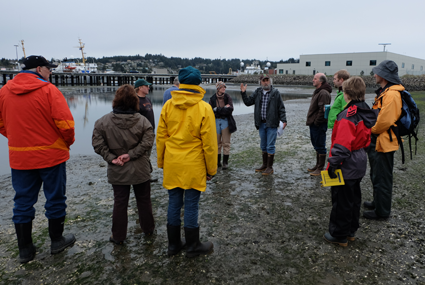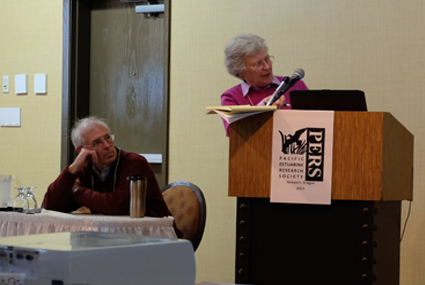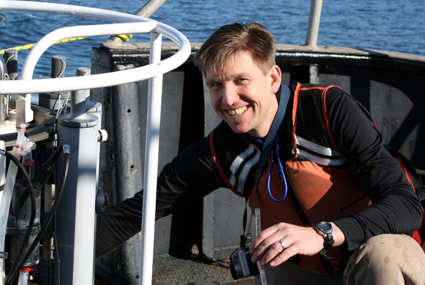- About
- Affiliates
- Join
- Publications
- Estuaries and Coasts
- CERF's Up! Quarterly Bulletin
- Coastal & Estuarine Science News (CESN)
- CERF-Lit
- Advertising
- Programs & Events
- Inclusive Culture
- Communities
2014 Annual Meeting Held 3-5 April 2014 in Newport, OregonThis year, Oregon hosted the 37th Annual Meeting in Newport at the Hallmark Inn and Resort. Approximately 114 PERSians gathered to reconnect with their friends and colleagues, exchange ideas, and revitalize the collective Pacific Northwest estuarine research community. Tony D’Andrea, PERS president, organized the meeting with the assistance of co-chair Steve Rumrill (Oregon Department of Fish and Wildlife or ODFW) and the conference committee - Brett Dumbauld, USDA-ARS; Ted DeWitt, US EPA; Jeannie Gilbert, PERS Secretary Treasurer; Gary Williams, PERS Past President; and Elizabeth Perotti, ODFW. Jude Apple, the new PERS President-Elect, once again did an excellent job organizing and managing student judging and student awards. The conference planning committee was ably assisted by a number of PERSians who volunteered to serve as Session Chairs and Student Judges. A special PERS thank you goes to Oregon Sea Grant which was a major sponsor of the meeting. Most of this sponsorship was used to support students during the meeting including reduction of student registration fees and providing student travel support. A small group of enthusiastic estuarine scientists gathered on the morning of 3 April in the misty sunshine typical of the Oregon spring for an optional field trip to kick off the meeting. Steven Rumrill guided participants on a tour of an eelgrass restoration site on Yaquina Bay in Newport, OR. The site is being restored as part of the mitigation requirements for the recently built NOAA Marine Operations Center-Pacific (MOC-P) Facility near the Hatfield Marine Science Center. He shared with the participants the approaches used in the restoration project, successes and challenges to date, and the role of Oregon state agencies in resource mitigation as a condition of dredge-fill permits in the estuaries of the state. Thursday evening was the official start of the meeting with the traditional Thursday Night Social Mixer held at the Rogue Ales Brewers on the Bay facility overlooking Yaquina Bay. The Rogue Brewery is a leader among the craft breweries of Oregon and has already contacted the CERF 2015 Conference Planning Committee about sponsorship opportunities for the upcoming meeting in Portland. The social was well attended by PERSians from Oregon, Washington, and British Columbia who enjoyed the appetizers, salads, craft beers, and catching up with their colleagues in a relaxing atmosphere. During the mixer, Rogue staff gave tours of the brewery facilities, the Rogue Museum, and the relatively new distillery present at their Newport location. The scientific sessions began on Friday and included 29 oral presentations in 7 sessions and 39 posters. The PERS annual meeting promotes student participation in the society and over 1/3 of the presentations at the 2014 meeting were given by undergraduate and graduate students. For some of these students, this was the first time presenting their research in a professional meeting. Another feature of the scientific program was the Poster Blitz on Friday morning which gave all poster presentations an opportunity to identify themselves and give a short two-minute summary of their posters. This is the second meeting that this approach has been used for poster presentations and has provided a great introduction to the poster sessions during the meeting. The Friday oral sessions were immediately followed by the PERS business meeting. The meeting began with a changing of the guard on the executive board. Two members of the board – Steven Rumrill (Past President) and Pascale Goertler (Student Member-at-Large) – were recognized for their past service. There was also a passing of the gavel as Tony D’Andrea took over as PERS President and Gary Williams transitioned to Past President. There were recent officer elections for two positions and the results were announced at the meeting: Jude Apple from Western Washington University was elected as the new President-Elect and Emily Lemagie from Oregon State University was elected as the new student representative. The audience welcomed them both to their new positions on the executive board. In addition, one of our active PERS members, Jason Stutes, has recently moved to Alaska and shared with the board his willingness to promote PERS in that region. He was nominated and appointed to a new Member-at-Large position for Alaska to formalize his role for PERS. More information about each new PERS Board member can be found in the article below. Other major topics at the meeting included PERS membership levels, the upcoming CERF 2015 Meeting in Portland, and the location for the 2015 Annual meeting. PERS Membership was also discussed at the business meeting. Although PERS has had the same issue as other societies with falling membership, a bump in membership over the past year including several new members at the 2014 meeting bring the current membership at 109 consistent with membership over the last five years. Walt Nelson, one of the CERF 2015 Meeting Co-Chairs along with fellow PERSian Ron Thom, gave a brief overview of the planning for the Portland meeting and provided an opportunity for members to provide feedback on what has or has not worked in previous meetings. At the end of the meeting, Charles (Si) Simenstad and Jude Apple volunteered to be the co-chairs for the 2015 Annual PERS Meeting in Seattle on the University of Washington campus. The most lively discussion at the business meeting was in response to the results of a recent PERS membership and social media survey spearheaded by Jude Apple. There were many good ideas discussed on ways for PERS to provide more communication and services to the membership. Some of these ideas included improvements to the website (e.g. links to more PNW publications and member research), increasing student professional development opportunities at the annual meetings, and continuing to develop the social media aspects of PERS. In response to this feedback from the membership, Stuart Munsch and Emily Lemagie both volunteered to work on a new social media committee with oversight from the Executive Board. Overall, it was a very constructive and productive meeting that will help the PERS Board moving forward in 2014. The PERS Banquet was held after the business meeting on Friday night and included a keynote address by Dan Bottom who has studied Pacific salmon for the last 35 years with both NOAA and the ODFW. His presentation entitled “Oregon experiments in estuary conservation: Is salmon management good estuary management” included a multi-decadal historical perspective on water and estuary management in Oregon and how that has changed from the 1960s to the present. It was well received by the audience and a nice bookend to the scientific sessions on Friday. The scientific sessions on Saturday began with an invited plenary talk given by Sarah (Sally) Woodin and David Wethey from the University of South Carolina titled “Biogeography of ecosystem engineers: Community ramifications”. Over the last 40 years, their research has covered the areas of population and community ecology, biogeography, and climate change in rocky intertidal and soft sediment environments. Their talk presented some of their research testing mechanisms of biogeographic shifts of estuarine and rocky shore invertebrates in response to short-term climate forcing and the potential impact of these changes on benthic communities. Sally and David stayed in Newport for several days after the meeting to meet with several PERSians about data sources and future collaborations in the Pacific Northwest. The scientific oral and poster presentations ended after lunch and the meeting concluded with the presentation of student awards, closing comments, and acknowledgements for the sponsors and volunteers. The Newport meeting continued the tradition of good science, exciting presentations, vigorous discussions in a collegial environment that supports student participation in the society. Financially, the meeting was also profitable allowing both an increase in the PERS conference fund for future meetings and $1000 added to the Eldridge Memorial Fund that supports student research. Members left energized and looking forward to the Seattle meeting in 2015.
2014 Student Award WinnersPERS is proud to salute the student award winners and wants to acknowledge the excellent effort of all the oral and poster presenters. This year the winners were: Don Heinle Award for Best Overall Student Presentation Best Graduate Oral Presentation Honorable Mention Graduate Oral Presentation Best Graduate Poster Presentation Honorable Mention Graduate Poster Presentation Best Undergraduate Student Presentation Honorable Mention Undergraduate Student Presentation
Welcoming New Members of the PERS Executive Board
Jude Apple, President ElectI arrived in the Pacific Northwest in early 2008, relocating from the estuaries of the mid-Atlantic to take a position as a Marine Scientist at Shannon Point Marine Center. One of the first things I did after arriving was to attend the PERS meeting in Newport, and I was both comforted and excited to have found such a welcoming community of like-minded estuarine scientists who shared commitment to understanding, preserving and supporting education of estuarine and coastal ecosystems. I have been an active member of PERS ever since. My involvement with PERS has varied over the years. In 2009 I worked closely with Jim Brennan and Jeannie Gilbert to organize the PERS meeting in Bellingham, serving as coordinator of the scientific program and helping assemble a panel on “bridging the gap between science and management”. Over the past few years I have transitioned into a role of promoting and highlighting undergraduate and graduate student involvement in the annual meeting by coordinating student judging and awards. This has been a growing (and important) focus of PERS that I am happy to be a part of and look forward to continuing our growth in this area, as the annual meeting is an excellent setting for students to become more comfortable presenting their research. I am also interested in helping PERS continue our transition into the 21st century by exploring ways that technology can best serve the needs of the PERS community – as well as enhancing our impact on the greater community of scientists, managers, students and citizens concerned about coastal and estuarine resources in the Pacific Northwest. In this time of increasing coastal development, growing population, and climate change, I believe that PERS and its constituents are poised to make a strong collective contribution to our growing understanding of the impacts of these changes to coastal ecosystems and resources, and that we offer valuable insight for adaptation strategies. I would like to work with the PERS community to explore mechanisms – either through annual meetings or beyond – that our organization as an entity can be more deliberate about addressing local and regional challenges facing our coastal and estuarine ecosystems. ---
Emily Lemagie, Student Member-at-Large It is easiest to illustrate why I chose to become PERS Student Rep through a brief anecdote of how I became a PERSian: Coming out of my first year as a master’s student, I was growing increasingly nearsighted from long hours spent with my head buried in books or bobbing precariously close to a computer screen. Graduation was already looming and my psyche was nagging me to figure out where I was taking my career and how my work fit into the grander picture. It had been a long Northwest winter and I hadn’t seen much sun in months. Maybe coral reefs were in more need of my scientific scrutiny than these tiny pacific coast estuaries? I arrived at the 2011 annual meeting in Astoria with my poster fresh off the printer, hoping that the loss of three days of research would be balanced by some useful feedback, a line on my resume, and, to pass the time, a few interesting talks–maybe even one or two in my field. What I found instead was PERSpective. Most of the talks were in separate disciplines, but they followed a thread that was relevant to me. Many displayed photos of researchers stuck in the mud and I thought, "I’ve been there." The tools for collecting data on mudflats and in shallow estuaries are interdisciplinary; so is the larger goal. As I made more and more connections, they challenged me to think about my research in a more creative and holistic context and to better appreciate the role of my niche interests and expertise in estuarine research. I still remember the conversations that I had at that meeting, and it was the first time I was handed a business card and asked to collaborate with another researcher. My work was well received, but more importantly, people were interested in what I was going to do. The experience expanded my mindset of how my own work fit into estuarine science more broadly and strongly motivated my decision to pursue a PhD. I came away feeling like part of a community–and when I showed up at CERF later that year, I knew people. PERS is the kind of group that inspires people to want to give back, and I am excited for this opportunity. A Little About Me: I am an Oregon State University (OSU) first year PhD student in Physical Oceanography studying the freshwater output from Oregon coast estuaries. For the last five years I have conducted research with Jim Lerczak at OSU, where I received an MS in Marine Resource Management as an Oregon Sea Grant Malouf Scholar and then worked as a Faculty Research Assistant on numerical modeling and field projects in three Oregon estuaries. I recently submitted a paper to Estuaries and Coasts about estuarine residence time. Prior to coming to OSU, I started my oceanographic career working in labs at the University of Washington and the Hatfield Marine Science Center (HMSC) in Chemical, Geological, and Biological Oceanography. I continue to value and apply an interdisciplinary aspect to my science, having developed an exhibit about the transport of Olympia Oyster larvae in the Yaquina Bay at the HMSC Visitor Center, an Individual Based Model interface for a graduate level ecology class, and collaborating closely with scientists, managers, and educators across disciplines in my research. ---
Jason Stutes, Alaska Member-At-Large I am a classically trained marine ecologist with over 12 years of research and consulting experience in marine habitats around the globe specializing in nearshore ecology and ecosystem connectivity. For the last 7 years I have focused on Alaskan marine and aquatic systems around the state. Specifically I have focused on studies of nearshore ecosystems evaluating them for project related impacts, ESA-listed species utilization, mitigation/restoration potential, and potential contamination threats. I have consulted for numerous design teams on various waterfront projects where impacts to sensitive natural resources need to be addressed in order to maintain project progress and cost effectiveness. In general, I have spent my career becoming well versed in nearshore/aquatic habitats with particular emphasis on functional resources and their ecosystem services. I am a recognized expert in nearshore and benthic ecology and periodically review articles for international journals on the subject. |






